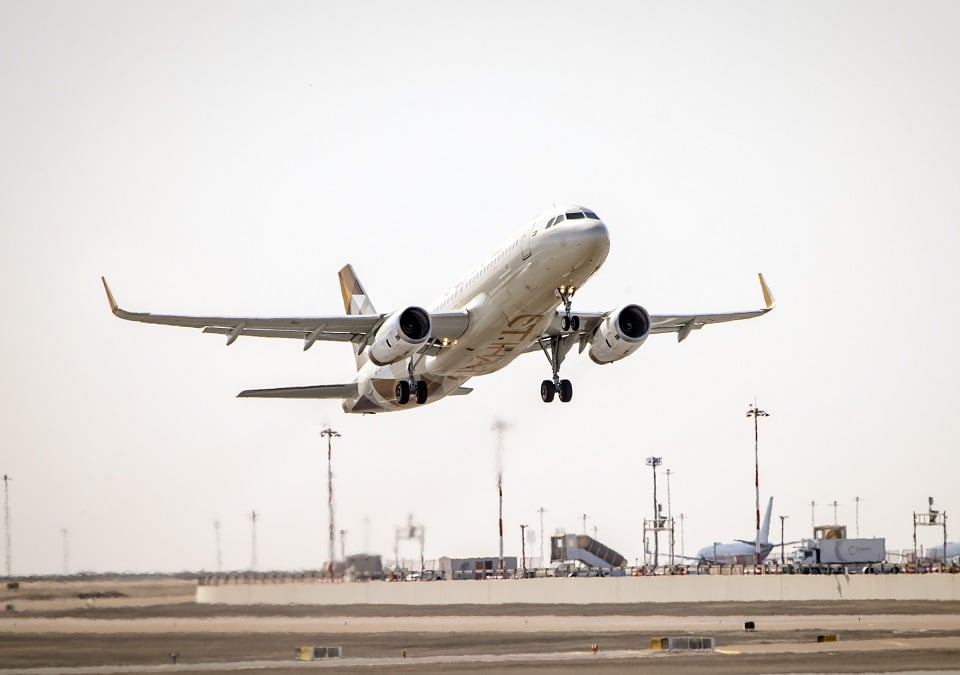Aviation
AirFi’s Wireless IFE Now Available on 10 New Etihad Airbus A320s

Etihad Airways has enhanced the passenger experience on its Airbus A320 fleet by integrating AirFi’s cutting-edge wireless in-flight entertainment (IFE) platform.
This upgrade, which saw 10 Airbus A320 aircraft equipped with AirFi’s technology, marks a significant leap forward in the airline’s in-flight service offerings.
From its hub at Abu Dhabi International Airport, Etihad’s newly equipped A320 aircraft now provide passengers with complimentary access to a diverse range of in-flight entertainment via their mobile devices.
By connecting to the onboard Wi-Fi network powered by AirFi’s portable streaming technology, travelers can stream a wide selection of premium content, mirroring the high-quality experience found across Etihad’s entire fleet.
Etihad premium economy vs Emirates premium economy: Which Airline Is Best?:Click
The swift implementation of this upgrade is notable, with the AirFi platform going live in under a month following the signing of the contract between Etihad and AirFi. This rapid turnaround underscores the efficiency and commitment of both parties in enhancing passenger comfort and entertainment.
Egle Paleviciute, AirFi’s Sales Manager, expressed enthusiasm about the partnership, stating, “As a national carrier of the UAE, Etihad is a very discerning airline with incredibly high standards and a clear vision of its future as part of its ‘Journey 2030’ growth plan, so working with them is an honour. We look forward to a fruitful partnership that will bring Etihad’s exceptional content library and award-winning user experience to more passengers than ever before.”
Etihad Airways set to reintroduce its much loved A380 fleet:Click here
The AirFi box, integral to this upgrade, not only facilitates the streaming of entertainment but also supports AirFi’s broader range of airline solutions. These include Connected Crew and AirFi LEO Connectivity, the latter of which earned the 2023 Crystal Cabin Award for best IFEC and Digital Services.
With the potential for expanding this agreement to include additional aircraft, the collaboration between Etihad Airways and AirFi signifies a major step in the airline’s commitment to delivering exceptional in-flight experiences, etihad premium economy aligning with its ambitious “Journey 2030” growth strategy.

Aviation
COMAC Unveils Plans for the C929 to Rival Airbus and Boeing

After the success of China’s first C919 aircraft, the country is setting its sights on developing a larger plane. COMAC (Commercial Aircraft Corporation of China) has officially confirmed plans to build a widebody aircraft, marking a significant step in its aircraft lineup.
Traditionally, Airbus and Boeing dominate the widebody aircraft market, with decades of expertise in developing planes and engines capable of carrying heavy payloads. China, which currently relies on imported engines, is now aiming to challenge these giants with its own widebody jet, the C929, designed to compete with the Airbus A350 and Boeing 777.
American Airlines Is Looking for Flight Attendants: Apply Now
The C929 will be China’s first independently developed long-range widebody aircraft. It adheres to international airworthiness standards and boasts independent intellectual property rights. The baseline version is designed to seat 280 passengers and offers a range of 12,000 kilometers, catering to global demand for both regional and international air travel.
Russia, which also needs reliable narrowbody and widebody aircraft, could become a key customer for the C929. Additionally, China plans to target the broader Asian market as it continues to expand its aviation capabilities.
Close Call at Heathrow: BA Flight Narrowly Escapes Drone Collision
China’s aviation progress includes the ARJ21 (now called C909), a regional jet with 100 seats for shorter routes, and the C919, a narrowbody jet with 180 seats designed to rival the Boeing 737 MAX and Airbus A320. Both models have found increasing demand in the domestic market.
At China’s largest air show in Zhuhai, COMAC announced that Air China will be the launch customer for the C929 widebody jet, though details about order size and delivery timelines were not disclosed.
Other major deals announced by COMAC include:
- Hainan Airlines: Firm orders for 60 C919 and 40 C909 regional jets.
- Colorful Guizhou Airlines: 30 C909 jets, with 20 firm orders and 10 provisional agreements.
The C929, renamed from the CR929 after Russia withdrew from the joint development project in 2023, is expected to carry 280–400 passengers with a range of 12,000 kilometers, competing directly with Boeing’s 787 Dreamliner.
According to COMAC’s deputy general manager, Tong Yu, the first fuselage section of the C929 is expected by September 2027, with prototype test flights anticipated soon after.
-

 Aviation2 months ago
Aviation2 months agoMicrosoft Flight Simulator Raises $3 Million to Bring Back the An-225 Mriya
-

 Airlines2 months ago
Airlines2 months agoQantas Engineers Stage Walkout Over Cost of Living Concerns
-

 Airlines2 months ago
Airlines2 months agoQatar Citizens Can Travel to the United States Without a Visa
-

 Aviation2 months ago
Aviation2 months agoQatar Airways bans these new Electronic Devices on plane
-

 Airlines2 months ago
Airlines2 months agoJapan Airlines Rolls Out Free Domestic Flights to International Passengers
-

 Defence2 months ago
Defence2 months agoWhich Country Has the Largest Fleet of Fighter Aircraft?
-

 Airport2 months ago
Airport2 months agoWestern Sydney Airport Welcomes Its First Plane After 6 Years of construction
-

 Aviation2 months ago
Aviation2 months agoDid you know ? Once Boeing 747 carried 1088 passenger in 1991








